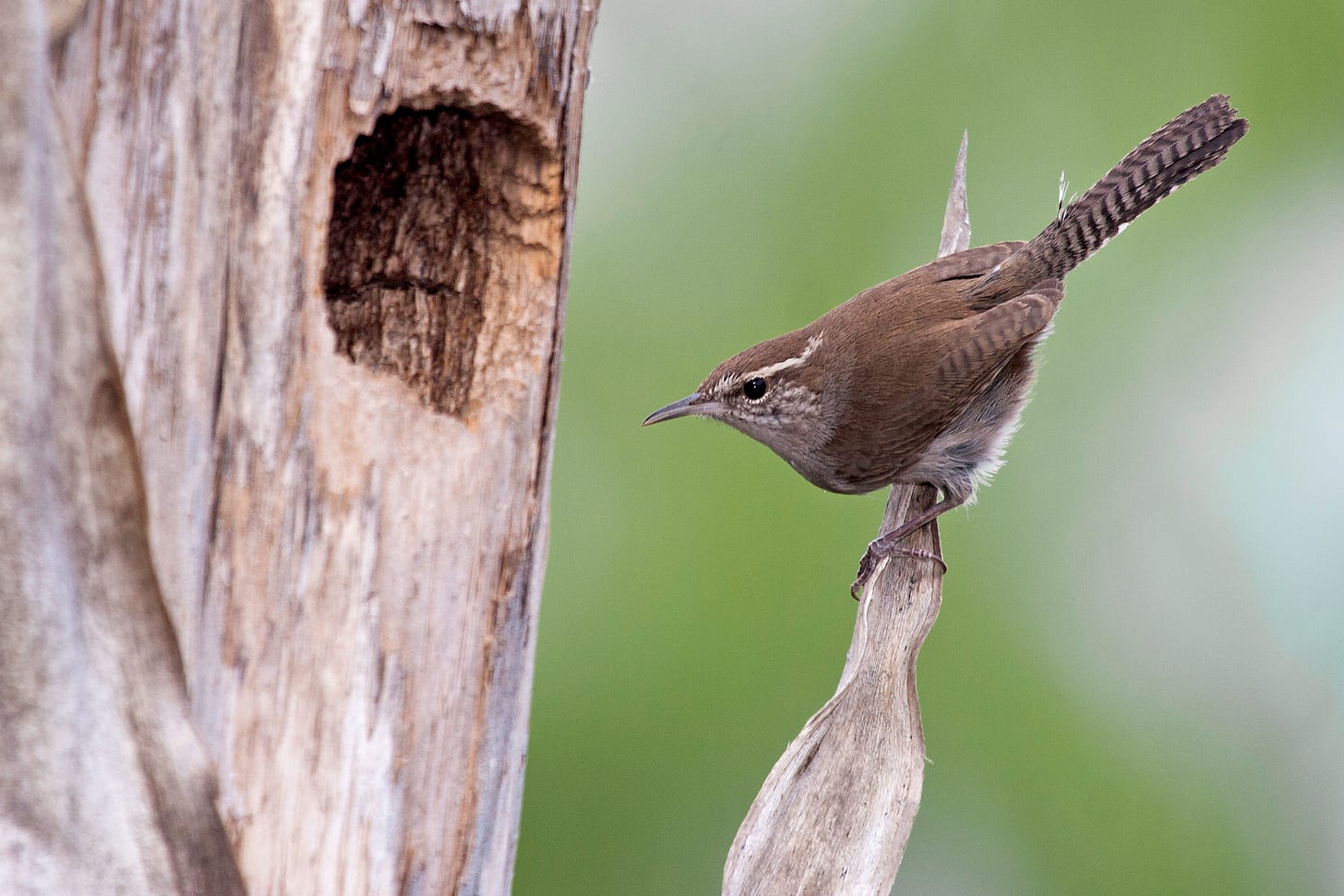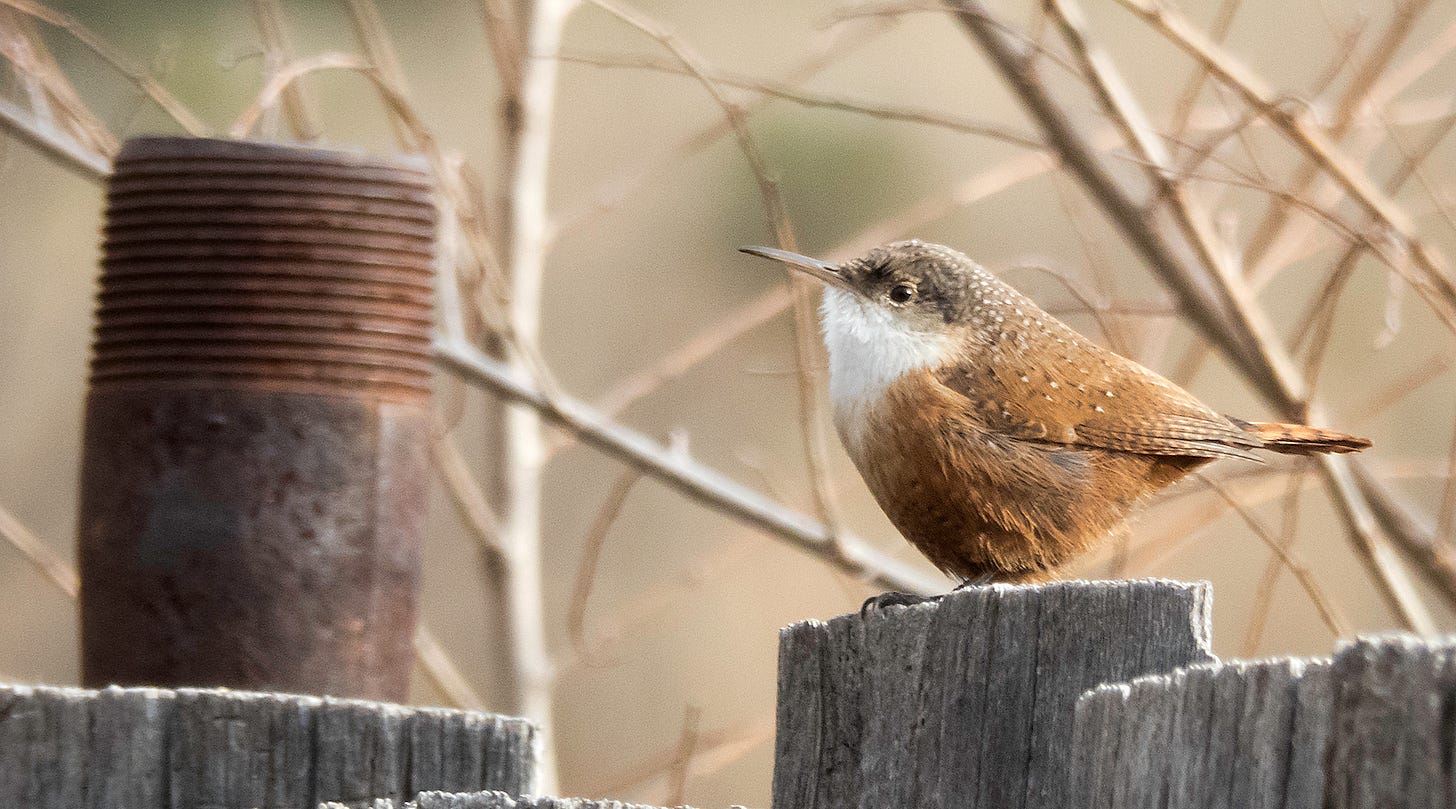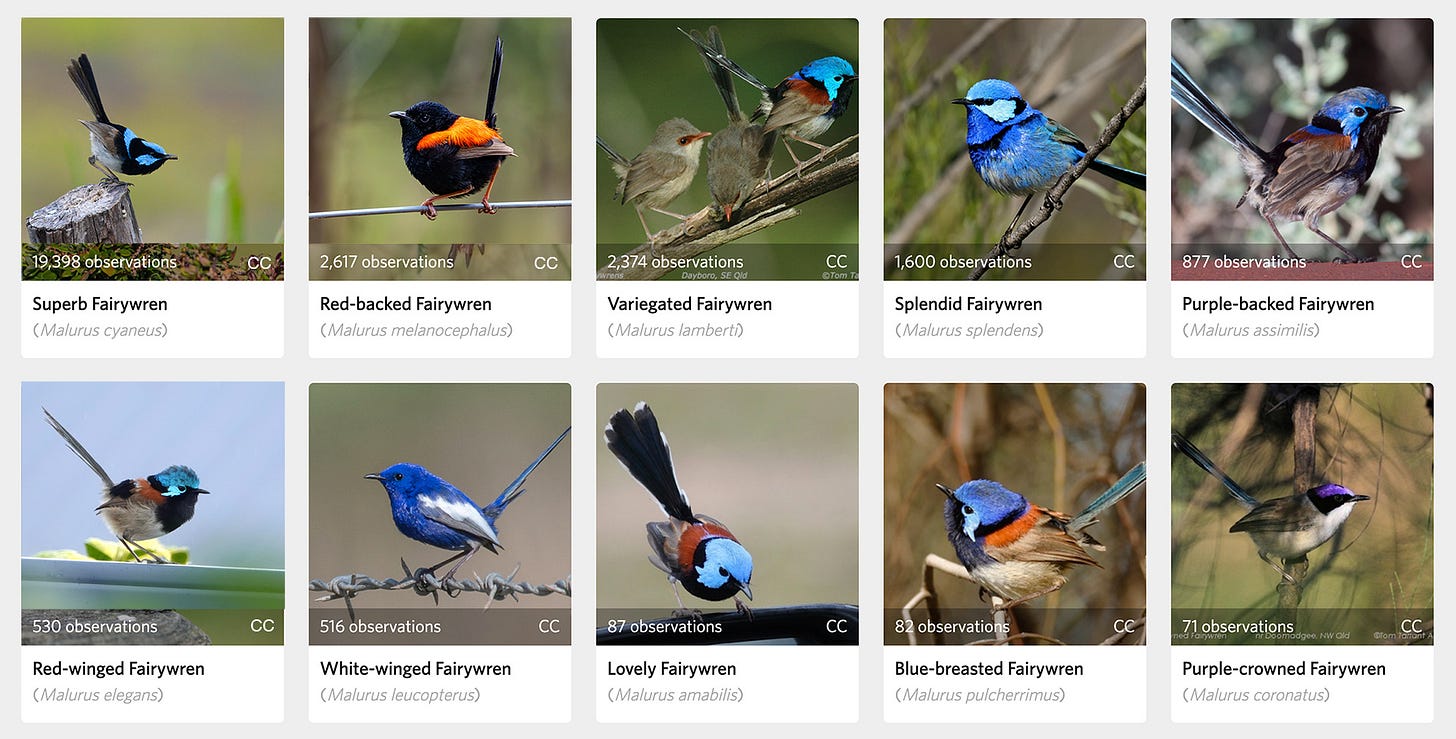ALTHOUGH THEY FLIT through verses of poetry and sing like there’s no tomorrow, here’s the rub on wrens: hardly flashy in plumage, they are too often dismissed as LBBs (Little Brown Birds).
Except for the fairywrens of Australia and New Guinea, of course, which flash incandescent azure, violet, and rust, but which are unrelated to the wrens most of us encounter in our backyards and beyond.
Although I include a montage of those fairywrens for you below, this post features a prosaic Bewick’s Wren investigating a nest cavity along the Rio Grande. It is a worthy wren today (every day, actually) because at long last I bring you some housekeeping — assorted news and ideas from the frontiers of nature, including human nature (my nature as well), before I return to reporting from the vanguard of springtime here in the Northern Hemisphere. Along the way in this post, you’ll find additional wren charisma and shoutouts to a few Substack writers I’ve come to admire and therefore you might as well.
How I Read (and Avoid the Phone)
I am by nature easily distracted. So in order to manage my time and spend more of it outside and with people and the dog I love, I do not read news or essays on my phone — not even most of the three dozen Substack writers I follow (10 of whom with paid subscriptions). So in addition to avoiding social media, here’s my strategy for liberating myself from the phone and computer (including when I write) for more time and attention in nature:
SUBSTACK — I elect not to receive any Substack posts by email. The Substack app is fine enough, but I’m not much of a scroller either. So whether I first encounter posts in the app or in the Substack Inbox on my laptop’s browser, my usual practice is to send the posts to my Kindle Paperwhite for dedicated reading later.
Granted, the Paperwhite is yet another screen — so many of you may view this as a distinction without much of a difference. But my Kindle is walled off from the internet, with text in black-and-white, and most importantly my library for studious, offline reading — in my rocking chair by the wood stove, for example, or in my tent (where I will be based during an upcoming road trip to meet and report for you on the arrival of spring). Segregating my reading off the phone this way keeps me from wandering toward online distractions (because even worthy online distractions are infinite in number). More like reading a book, I’ll take the Kindle over my phone or laptop any day. Well, uh, most of the time. …
Reading Substack writers on the Paperwhite comes with downsides (which I’ll expand upon in a Postscript), the most obvious of which is that photography and graphics are delivered in black and white and that I don’t have the option to follow even a select few of those worthy internet links. As a result, I sometimes reserve my laptop’s browser — not my phone — for reading certain Substack writers. To name a few: David E. Perry’s
and his beautiful photography; Sabrina Y. Smith’s and the places she sends us, Terry Allen’s provocative photography at , and the wellspring of eco-information (many links) from Mike Shanahan’s.Among the very few Substack writers I reserve for my phone is Chloe Hope, who writes
. For her posts, I sit or recline, eyes closed as if in meditation, phone by my side, and simply listen to Chloe read aloud her essays. I also welcome on my phone poetry from MK CREEL who writes — because we all need good poetry at any time of day.DAILY NEWS and LONG READS — Rather than slouching over my phone, once a day I instead browse the news from my stable of newspaper and other websites (including Aeon) and push articles (with a click of my internet browser’s plug-in, which strips away ads and other extras) to the Kindle for reading later. As a result, I’m more attentive when I read, for example, Bill McKibben’s
, Jason Anthony’s, Antonia Malchik’s , or David Knowles’ (dammit, I wish I could write like that guy).SCIENTIFIC PAPERS — I print out many of them on paper (remember that stuff?) for reading and marking up. The same goes for a few journals I receive by PDF.
WRITING — I write first drafts of my essays — what Anne Lamott calls “the shitty first draft” — in my sacred LEUCHTTURM1917 hardbound notebook using one of my many beloved Pentel GraphGear 500 mechanical pencils. Only after marking up that text will I go to the laptop for the next draft (and lots of revision). If my house were on fire, and Ruth and our pup Odin were safe, the first thing I’d grab would be that notebook.
Overall, my reading system is far from ideal, of course, but I suspect most of us agree that we spend too much time with our phones, even in nature (which isn’t very natural). I recognize many of you prefer to read on phones, and are not eager to buy yet another device. That makes sense. Although I have my issues with Amazon, and prefer to buy actual books at my local bookshop, I will not lie to you: Whether by kerosene lamplight in a cabin off the grid or atop a granite cliff by the Atlantic Ocean, I do like reading on that Kindle.
A Wren and a Threaded Pipe
As it happens, the only decent photo I have of a Canyon Wren is from the dooryard of a cabin (with an exposed threaded pipe) at the foot of the Gila Mountains in New Mexico. Otherwise, these golden wrens mostly occupy canyon walls from which their songs tumble, echo, and turn stone into music. The reason I don’t have other Canyon Wren photos is probably because the best way to experience this songbird is to gaze up at the rock, close your eyes, and allow its bouncing song to wash over you like a warm, benevolent cascade. So, dear reader, move your cursor to that arrow below, close your eyes and imagine yourself in a slot canyon, then click and listen through two tumbling “wrenditions.”1
Butterflies and Sparrows
No, not the name of a new Substack. Those lovely animals will instead be flying soon toward Chasing Nature’s paying subscribers. The best way to learn butterflies is on a sunny day in a wildflower meadow. If you cannot join me in person for that, however, my subscribers at the yearly rate of $50 will get access to the video lectures accompanying my seminar titled Butterfly Ecology and Identification in July. Moreover, in time for spring migration in April, coming to the Chasing Nature Classroom will be my video lecture titled Solving Sparrows.
Natural Selections
If you find yourself in Montpelier, Vermont, USA, on 19 April 2024, stop in at the North Branch Nature Center for poetry, prose, and music, including my reading a couple of mini-essays — an event we writers and musicians have titled Natural Selections.
Gratitude (and more Reading)
Finally, before the fairy wrens, my appreciation of you. What elevates Substack above the online wasteland is that it comprises varied communities of readers and writers. I truly believe in that — and in the 5,600 of us who’ve gathered here at Chasing Nature in the year and some since I launched. If you have a Substack profile, I’ve read it — so that I might learn a bit about what you read and what you love.
Most of us together read bigger-name Substack writers who have huge subscriber lists. But I am particularly grateful for the many of you who’ve come here by way of
, , , , and . Meanwhile, for Substack writers who bring us closer to nature, I’m planning to host an online meetup specifically for us to share strategies. It’ll happen in April (with a bit of help from Substack). More on that to come.So here we are — a community of readers and writers. Thanks for being here. Now, at long last, those fairywrens (thanks to iNaturalist, with minor edits on my part to protect photographer copyright).
Postscript
Let’s be clear: a Kindle is hardly a path toward offline salvation and a less-cluttered mind. (A far better route, of course, is to avoid social media and even some news media, at the very least on the phone. I’ve all but abandoned TwitterX, Instagram, and Facebook2; and despite its sanity and worthy content, I remain an infrequent user of Substack Notes.)
As I mentioned above, the Paperwhite has its problems. As designed, the Chrome browser plug-in I use on my laptop to send reading to my Kindle usually pulls it off nicely. (Same goes for when I send content from the Substack app on my phone to the Kindle.) Basically, the plug-in delivers you advert-free, clean-text versions for your dedicated reading. Every now and then, however, maybe 5 percent of the time, the plug-ins deliver an empty document. Another drawback is that my reading of Substack writers on the Kindle doesn’t allow me to immediately interact with a “like” or a comment. Fear not, however: I’m indeed out here reading and liking (much of the time offline).
Credit: Xeno-canto (CC BY-NC-SA 4.0 DEED)
Facebook, TwitterX and their ilk, as Ted Gioia has pointed out, have gone to war with independent writers. Because their overlords don’t want you wandering off to read elsewhere, the social media platforms bury links to Substack writers. It is a pox upon our communities.








Beyond grateful to be included in this, and overjoyed that you choose to listen to Death & Birds in that way (I feel like it means that we kind of hang out together, in a sense!). I’m so excited for Solving Sparrows, and for all your upcoming offerings. Thank you for the way in which you champion your fellow writers alongside nature, Bryan. And thank you for that beautiful ‘wrendition’! 😂💛🌿
Thanks for the thoughtful post. I enjoyed hearing the wren song.